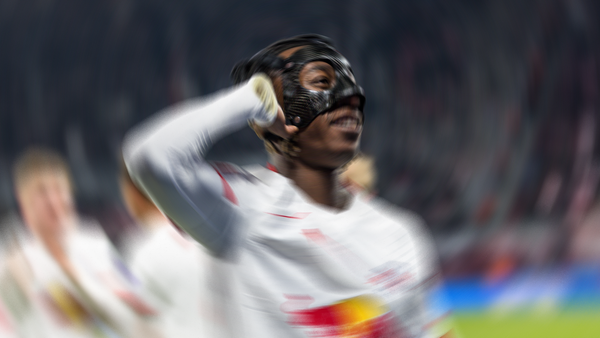A guide to Archetypes
A comprehensive primer for SCOUTED's player profiling project

PROJECT: Archetype is an ongoing quest to translate the football meta into RPG-inspired classes in order to better understand a player’s function on the pitch. It marries together two of Jake Entwistle’s core hobbies: video games and football.
Jake Entwistle is a data scout, analyst, and writer for SCOUTED. He is also the architect of Archetypes, a project to quantify the player profiles defining the new football meta. This is Monday Night SCOUTED, his weekly newsletter of data-led narratives from the weekend’s action. He does not use contractions, but his editor doesn’t does not mind.
Each Archetype represents a player profile in the modern game, spotted simply by watching football. Then, in order to accelerate the discovery of similar players, we attempt to translate the eye test into datapoints, discovering superpowers and transforming them into metrics.
Below, you’ll find an ever-expanding list of fully-developed SCOUTED Archetypes. We’ll add more as we workshop them and if you’re looking for more detail about the process, you’ll find that after the list.
🪽 Flyer
The function of a Flyer is Progression through Moving vertically from behind the ball, specifically through overlapping and underlapping runs, and Penetration through Passing from wide areas and the byline. Augmented by high-intensity. Most commonly associated to full-backs. Evaluated based on effectiveness.
🧭 Pathfinder
The function of a Pathfinder is Progression and Penetration through ambitious, difficult Passing over long distances from deep in the middle third or even the defensive third. Most commonly associated to centre-midfielders. Evaluated based on effectiveness.
🎼 Platformer
The function of a Platformer is Possession and, to a lesser extent, Progression through metronomic Passing in the defensive and middle third, usually orchestrating build-up patterns from central zones. Most commonly associated to centre-midfielders. Evaluated based on effectiveness and efficiency.
💣 Defuser
The function of a Defuser is Possession through Retaining the ball in the face of opposition pressure in central and half-space channels within their own half. They flip pressure into positives. Most commonly associated to centre-midfielders. Evaluated based on efficiency.
📈 Developer
The function of a Developer is Progression through Moving ahead of the ball. They run behind and beyond lines in the middle and final third, across the width of the pitch, turning build-up into promising attacks. Augmented by high-intensity movement. Most commonly associated to midfielders. Evaluated based on effectiveness.
🍽️ Ground Eater
The in-possession function of a Ground Eater function is Progression through Moving and Carrying specifically over large distances in central areas, up and down all thirds of the pitch. This profile is one of the few that also considers an OOP role. In addition to the large distances covered to support attacks, the Ground Eater makes equally as large recovery runs to defend transitions and quick breaks. Most commonly associated to midfielders. Evaluated based on efficiency.
💨 Roadrunner
The function of a Roadrunner is Progression through high-volume Carrying in wider areas and, to a lesser extent, Dribbling. Players should ‘Meep! Meep!’ past their opponents. Augmented by explosive speed. Most commonly associated to wingers who act as release valves for their teams. Evaluated based on effectiveness.
🔓 Safecracker
The function of a Safecracker is Penetration and Production through Passing in the final third. This profile is characterised by the ability to find creative passing solutions and execute difficult and dangerous passes in the face of low blocks. Most commonly associated to attacking midfielders. Evaluated based on effectiveness and efficiency.
🧲 Gravitar
The function of a Gravitar is Possession through Retaining the ball after attracting and absorbing pressure in advanced central areas. They are relatively static and use their gravitational pull to bring the game and opponents towards them to create space for teammates. Most commonly associated to strikers. Evaluated based on efficiency.
💪 Power Forward
The function of a Power Forward is Penetration and Production through Moving, specifically bulldozing carries and sprints that break the last line. This profile is characterised by physical power: size, speed and power-striking. A more emotive name you may see used is Juggernaut. Most commonly associated to strikers. Evaluated based on effectiveness.
⛺️ Goal Hanger
The function of a Goal Hanger function is Production through Moving and Shooting. Also known as a Camper, they pitch a tent inside the opposition penalty area and are barely involved in any other phases of play. They are high-volume shooters from all angles inside the box. Most commonly associated to strikers. Evaluated based on effectiveness and efficiency.
Beyond specific player profiles, we have also developed key terms to explain particular stylistic traits.
💥 Gamebreaker
The Gamebreaker tag is used for players that achieve Penetration through Passing, Carrying and/or Moving. This is a composite Archetype that is used to describe players able to achieve Penetration through multiple means with super effectiveness, hyper efficiency or even both.
🪡 Gameweaver
The Gameweaver tag is used for players that achieve Progression through Passing, Carrying, Moving and/or Dribbling in the final third. This is a composite Archetype that that is used to describe players that achieve this function through multiple means with super effectiveness, hyper efficiency or even both.
🫧 Luxury Player
Luxury is a term used for specific Archetypes or players that focus the majority of their efforts, in particular physical exertion, when their team has possession of the ball. This concept was a byproduct of the Gamebreaker analysis. Read more.

How to develop an Archetype
If you’re wondering why certain words were capitalised and in bold, here’s an in-depth look into the process of developing Archetypes. At the heart of each profile are the four Ps:
- Possession: securing and circulating the ball
- Progression: moving of the ball towards goal or through all-but the last line
- Penetration: getting the ball into the penalty area or breaking the last line
- Production: end product as defined by goals/assists, shots/shot assists
The idea is that each profile will have a unique set of primary and secondary functions relative to their role on the pitch. Another unique aspect of each profile is the means of achieving these functions:
- Shooting: derivatives include technique, location, volume
- Passing: derivatives include type, length, volume, accuracy, difficulty
- Moving: movement without the ball
- Carrying: moving with the ball
- Dribbling: creating separation or beating players through ball manipulation
- Retaining: attracting, resisting or overcoming opposition pressure
A player’s principal means of achieving their primary function is their superpower. To visualise this framework, we’ll use one of the most robust Archetypes: the Pathfinder.
Inspired by Trent Alexander-Arnold, the primary function of the Pathfinder is Progression, the secondary is Penetration and their superpower is Passing. That’s how simple it is.
Thanks to our partnership with SkillCorner, this was originally developed as a full-back Archetype. Using their data, we have been able to craft, interrogate and refine player profiles and although each profile will be most commonly associated with a specific position, we found that certain traits could transcend the team sheet. The Archetype should depend on a player’s role within a team not their positional label.
As another example, the Imposter full-back Archetype inspired by Myles Lewis-Skelly is based on his instructions to invert and become involved in the build-up phase. A midfielder wearing full-back pyjamas. Although the Imposter tag is useful to denote a deviation from his expected role based on the team sheet, it may be better served in the future as a prefix rather than an Archetype in itself. As Lewis-Skelly’s primary in-possession function is to flip pressure into positive situations, he profiles as a Defuser. Given his deployment at left-back, you could call him a Defuser Imposter.
The same applies to the Pathfinder example. Most full-backs are not tasked with the responsibility to progress the ball and penetrate the penalty area, this is usually reserved for midfielders and wingers. So, Trent Alexander-Arnold could be called an Pathfinder Imposter. But even then, as the Archetype project develops, it makes sense to keep the nomenclature as simple as possible.
However, there is something to be said for where on the pitch a player looks to achieve their function. So, instead of positions, Archetypes can also be separated by their Area of Effect (AOE). Both Lewis-Skelly and Alexander-Arnold operate primarily in the middle third and in central or at the very least half-space areas. This is their AOE.
A Defuser is any player that secures Possession through Retaining the ball in the middle third. A Pathfinder is any player that achieves Progression and Penetration through Passing in the middle third. These two Archetypes have the same AOE but contrasting functions. Therefore, they require different skillsets and should be evaluated in different ways. That is the final step.
The Evaluation process is inspired by a framework laid out by M.H. in his Spielverlagerung article about Chance Conversion. He explained that chance conversion can be improved by two approaches:
- Increasing effectiveness (indirectly improves the conversion rate)
- Increasing efficiency (directly improves the conversion rate)
I thought this could be applied to all player superpowers. To use the Pathfinder example once again, Trent Alexander-Arnold is one of the most effective players in the world at progressing the ball and penetrating the penalty area with his passing. However, given his ability to do so over ridiculously large distances with a repertoire of outrageously difficult passes, his approach is not efficient. Therefore, a Pathfinder is not judged on how efficient they are at achieving their primary function, they are judge purely on effectiveness.
Of course, if you were comparing a shortlist of players to fulfil this role, you could introduce efficiency in the final stage to separate the premium candidates. But effectiveness matters most for this particular Archetype.
Here is the Archetype framework in its simplest form:
- Functions: discover the player’s primary responsibility on the pitch using the four Ps: Possession, Progression, Penetration, Production
- Superpowers: discover their primary means of achieving that function: Passing, Carrying, Dribbling, Moving or Retaining and if physical traits can augment the output
- Area of Effect: discover which part of the pitch their superpower is most apparent
- Evaluation: discover if the profile should be judged by effectiveness or efficiency of achieving their function
The value of the Archetype then becomes communicating all of that information with one word. This refines and accelerates the player discovery process, provides clarity for team selection, squad building and player recruitment and offers an easy way to evaluate player success.
If you're interested, this Google Sheet shows an early draft of how I tried to define every metric I use and create when exporting data from FBref. This is not the final table. That's on the SCOUTED database.
In the future, we hope to produce a Pokémon-inspired type chart that shows how effective each Archetype is against a particular style of play. It should also be noted that although certain characteristics will translate from In-Possession (IP) Archetypes to Out-of-Possession (OOP) Archetypes - or even combine the two like a Ground Eater - we are keen to develop specific profiles for each phase of play. Superpowers available to the OOP Archetypes will included Destroying, Disrupting and Denying. But this is a work in progress.
The final thing to address is the Gamebreaker. Again, this was initially developed as a specific Archetype inspired by Mohamed Salah’s logic-defying effectiveness at penetrating the penalty area through Passing and Moving. Since writing that article, however, I think the term is too good not to use in a more widespread manner.
Gamebreaker is the PROJECT: Archetypes tag for any player achieving elite level Penetration or Production through multiple superpowers. This is the tag that allows us to separate the most elite players from the rest. Salah is a Gamebreaker because a player should not be, and does not have to be, effective at breaking the last line of defence with their passing and their movement. But he is.
The same applies to the Gameweaver tag. The difference is that we will use this for any player that achieves Progression at an elite level through multiple superpowers. Pedri is a great example of this.
Now that you have read the Archetypes primer, here is an ever-expanding list of articles that explore them further. Dive in.
- Brazil: the centre-back goldmine about to explode
- An introduction to Full-Back Archetypes
- Finding a nest for Full-back Flyers
- Breaking down Noah Nartey, the first Defuser
- Introducing: The Developer, our first midfield Archetype
- An introduction to the Power Forward
- An introduction to the Gamebreaker
- 2025 U-21 EURO: translating the eye test into data and discovering superpowers
- Finding the right massive number nine: a big German case study






